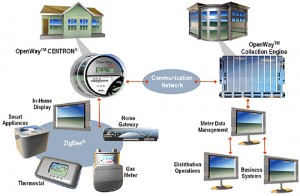Archive for the ‘Search’ Category.
30th March 2007, 09:49 am
 Wireless smart-grid solutions become ever more important with raisin energy costs. A smart grid is a digitally enabled electrical grid that gathers, distributes, and acts on information about the behavior of all participants in order to improve the efficiency, importance, reliability, economics, and sustainability of electricity services. Roll-out of smart grid technology also implies a fundamental re-engineering of the electricity services industry, although typical usage of the term is focused on the technical infrastructure. The smart grid represents the full suite of current and proposed responses to the challenges of electricity supply. Because of the diverse range of factors, there are numerous competing taxonomies, and no agreement on a universal definition.
Wireless smart-grid solutions become ever more important with raisin energy costs. A smart grid is a digitally enabled electrical grid that gathers, distributes, and acts on information about the behavior of all participants in order to improve the efficiency, importance, reliability, economics, and sustainability of electricity services. Roll-out of smart grid technology also implies a fundamental re-engineering of the electricity services industry, although typical usage of the term is focused on the technical infrastructure. The smart grid represents the full suite of current and proposed responses to the challenges of electricity supply. Because of the diverse range of factors, there are numerous competing taxonomies, and no agreement on a universal definition.
Numerous contributions to overall improvement of the efficiency of energy infrastructure is anticipated from the deployment of smart grid technology, in particular including wireless demand-side management, for example turning off air conditioners during short-term spikes in electricity price. The overall effect is less redundancy in transmission and distribution lines, and greater utilisation of generators, leading to lower power prices.
Some communications are up to date, but are not uniform because they have been developed in an incremental fashion and not fully integrated. In most cases, data is being collected via modem rather than direct network connection. Areas for improvement include: substation automation, demand response, distribution automation, supervisory control and data acquisition (SCADA), energy management systems, wireless mesh networks and other technologies, power-line carrier communications, and fiber-optics. Integrated communications will allow for real-time control, information and data exchange to optimize system reliability, asset utilization, and security.
Category:
Search |
Comments Off on Wireless Smart-Grid Solutions
26th February 2007, 07:12 pm
What is ‘domain kiting’?
In ‘domain kiting’ a registrar – or its PSEUDO client! – registers a domain and puts up mini-Web sites — loaded with search engine links — for domains names for which they never pay. When people land on these Web sites and click on the links, money is made. A registrar who participates in this scheme makes a large deposit at a registry. Then the registrar registers as many domain names as the deposit will allow. For example, if the registrar makes a $60,000 deposit at VeriSign Registry, they could register 10,000 .COM domain names as .COM names cost $6.00 per year. For each domain name registered, the domain kiting registrar puts up a simple Web site filled with search engine links and hopes users land on that page and click on the links. Anytime an Internet user lands on one of their mini-Web sites and clicks on one of the links, money is made.
After a domain name is registered, a registrar has five days to cancel a domain name registration – i.e. drop the name – and get their money back. Domain kiting registrars abuse this rule and cancel the lion’s share of the names they register just before the five day period expires – so they get their money back. But then something unexpected happens. After names are cancelled or dropped, the domain kiting registrar goes out and immediately registers the same names again. The domain kiting registrar will then put the same simple Web site back up for each domain name, wait another five days and then cancel all the names again — just in time to get a full refund. And for most names caught up in the domain kiting scheme, this process will repeat itself over and over and over.
By not actually paying for the names they are using, domain kiting registrars are able to generate profits, even if their mini-Web sites only generate 50 cents or more per year. And if they find, over time, that certain names never generate any revenue they stop registering them altogether. It’s only the names that have value – to you as an Internet user – they register over and over and keep off the market – names for which they of course never pay.
There are those cases when, if a domain name proves to be especially profitable, domain kiting registrars will actually step up and register the name. They’re not stupid. They won’t take a chance on losing a name that generates much more than the annual cost of a registration. However, this is clearly the exception.
Category:
Search |
Comments Off on Domain Kiting
25th February 2007, 09:24 pm
 Yesterday I got a chance to play with Google’s new offering – Google Apps Premier Edition – it features webmail, calendar, messaging, and voice applications, as well as a word processor and spreadsheet. It includes APIs to facilitate integration with a business’ other applications, and it lets businesses create a customized home page for single sign-on to all apps. Google charges $50 a year per employee for the service, including 10 GBytes of storage for ad-free GMail, service-level agreements for 99.9 percent uptime, and 24/7 tech support.
Yesterday I got a chance to play with Google’s new offering – Google Apps Premier Edition – it features webmail, calendar, messaging, and voice applications, as well as a word processor and spreadsheet. It includes APIs to facilitate integration with a business’ other applications, and it lets businesses create a customized home page for single sign-on to all apps. Google charges $50 a year per employee for the service, including 10 GBytes of storage for ad-free GMail, service-level agreements for 99.9 percent uptime, and 24/7 tech support.
First off: I really wanted to make it work. And I am also somewhat of a tech geek (duh). After two hours of trying to make the software work under one of my domains I finally gave up as I did not see the point of the offer – especially not if they expect me to pay anything for it.
A very jittery (if tha’s even a word) release that will decrease Google’s chances to take a shot at the big butterfly.
Category:
Search |
Comments Off on Google Aps a Microsoft Threat?
2nd February 2007, 09:21 am
What is your home on the web? – For most people the answer is one of these four sites:
* Google
* Yahoo
* MSN
* MySpace
Despite the huge popularity of Google which does an excellent job keeping the media guessing – and everybody likes a good mystery – Yahoo’s web sites actually have significantly more visitors than Google does. And the average Yahoo user spends four times as much time on Yahoo than he/she does on Google. The two main reasons are the Yahoo’s successful free email application and its superior content. After all, Yahoo started as directory striving to provide lots of great content. And email is still the number one usage of the Internet – despite the fact than more than 50% of all emails sent actually origin from a spam server.
Despite the fact that Google went on a shopping spree its traffic is almost exclusively originated through its search engine. And interesting enough the number one search term on Google is Yahoo. Most Internet users simply do not know what the “location” bar in their web browser is. Google probably wants you to only know and use a “web browser” like Microsoft Internet Explorer since that is where Google lives — on the Internet and “inside” the web browser. For many, though, Google pops up (or is bookmarked). So on those millions of machines it becomes the way to navigate the Internet. So million of web users just type “yahoo” into Google when they would like to check their email.
A popular saying says ‘home is where your heart is’ – and for most Internet users that still means Yahoo.
Category:
Search |
Comments Off on Home on the Web
28th January 2007, 11:37 am
 In October last year Google bought Wiki Startup JotSpot. JotSpot lets users collaborate on online documents, and offers both free and paid versions. JotSpot also allows users to create structured pages with photo galleries, file repositories, spreadsheets, calendars and documents.
In October last year Google bought Wiki Startup JotSpot. JotSpot lets users collaborate on online documents, and offers both free and paid versions. JotSpot also allows users to create structured pages with photo galleries, file repositories, spreadsheets, calendars and documents.
A wiki (sometimes spelled "Wiki") is a server program that allows users to collaborate in forming the content of a Web site. With a wiki, any user can edit the site content, including other users’ contributions, using a regular Web browser. Basically, a wiki Web site operates on a principle of collaborative trust. The term comes from the word "wikiwiki," which means "fast" in the Hawaiian language.
A wiki allows a visitor to the "wikified" Web site to edit the content of the site from their own computer. Visitors can also create new content and change the organization of existing content. The simplest wiki programs allow editing of text and hyperlinks only. More advanced wikis make it possible to add or change images, tables, and certain interactive components such as games.
A wiki provides a simplified interface. At any time, contributors can conveniently view the Web page as it looks to other subscribers, before and after the changes they have made. It is not necessary to know HTML (hypertext markup language) or perform work in HTML code. The best known example of a wiki Web site is Wikipedia, an online dictionary building collaboration.
JotSpot’s collaborative focus seems a good match for Google’s Office-like applications, such as Google Docs and Spreadsheets. Google released Google Spreadsheets in June 2005. Google purchased startup Writely.com, one of the more popular Web 2.0 office applications, last March. Focusing on collaborative products may also help Google attract more users to Internet apps, which is one of the search company’s goals. The more people who work online, the larger the audience for Google advertising. But the free and collaborative nature of Google’s applications alsoputs Google in a competitive position versus Microsoft, which has yet to make a big push in online collaboration. Microsoft currently offers an application called Windows Live Writer Beta, but has yet to announce online versions of its other traditional office products.
Category:
Search |
Comments Off on Why Google bought Wiki Startup JotSpot
 Wireless smart-grid solutions become ever more important with raisin energy costs. A smart grid is a digitally enabled electrical grid that gathers, distributes, and acts on information about the behavior of all participants in order to improve the efficiency, importance, reliability, economics, and sustainability of electricity services. Roll-out of smart grid technology also implies a fundamental re-engineering of the electricity services industry, although typical usage of the term is focused on the technical infrastructure. The smart grid represents the full suite of current and proposed responses to the challenges of electricity supply. Because of the diverse range of factors, there are numerous competing taxonomies, and no agreement on a universal definition.
Wireless smart-grid solutions become ever more important with raisin energy costs. A smart grid is a digitally enabled electrical grid that gathers, distributes, and acts on information about the behavior of all participants in order to improve the efficiency, importance, reliability, economics, and sustainability of electricity services. Roll-out of smart grid technology also implies a fundamental re-engineering of the electricity services industry, although typical usage of the term is focused on the technical infrastructure. The smart grid represents the full suite of current and proposed responses to the challenges of electricity supply. Because of the diverse range of factors, there are numerous competing taxonomies, and no agreement on a universal definition. Yesterday I got a chance to play with Google’s new offering –
Yesterday I got a chance to play with Google’s new offering –  In October last year Google bought Wiki Startup JotSpot. JotSpot lets users collaborate on online documents, and offers both free and paid versions. JotSpot also allows users to create structured pages with photo galleries, file repositories, spreadsheets, calendars and documents.
In October last year Google bought Wiki Startup JotSpot. JotSpot lets users collaborate on online documents, and offers both free and paid versions. JotSpot also allows users to create structured pages with photo galleries, file repositories, spreadsheets, calendars and documents.



